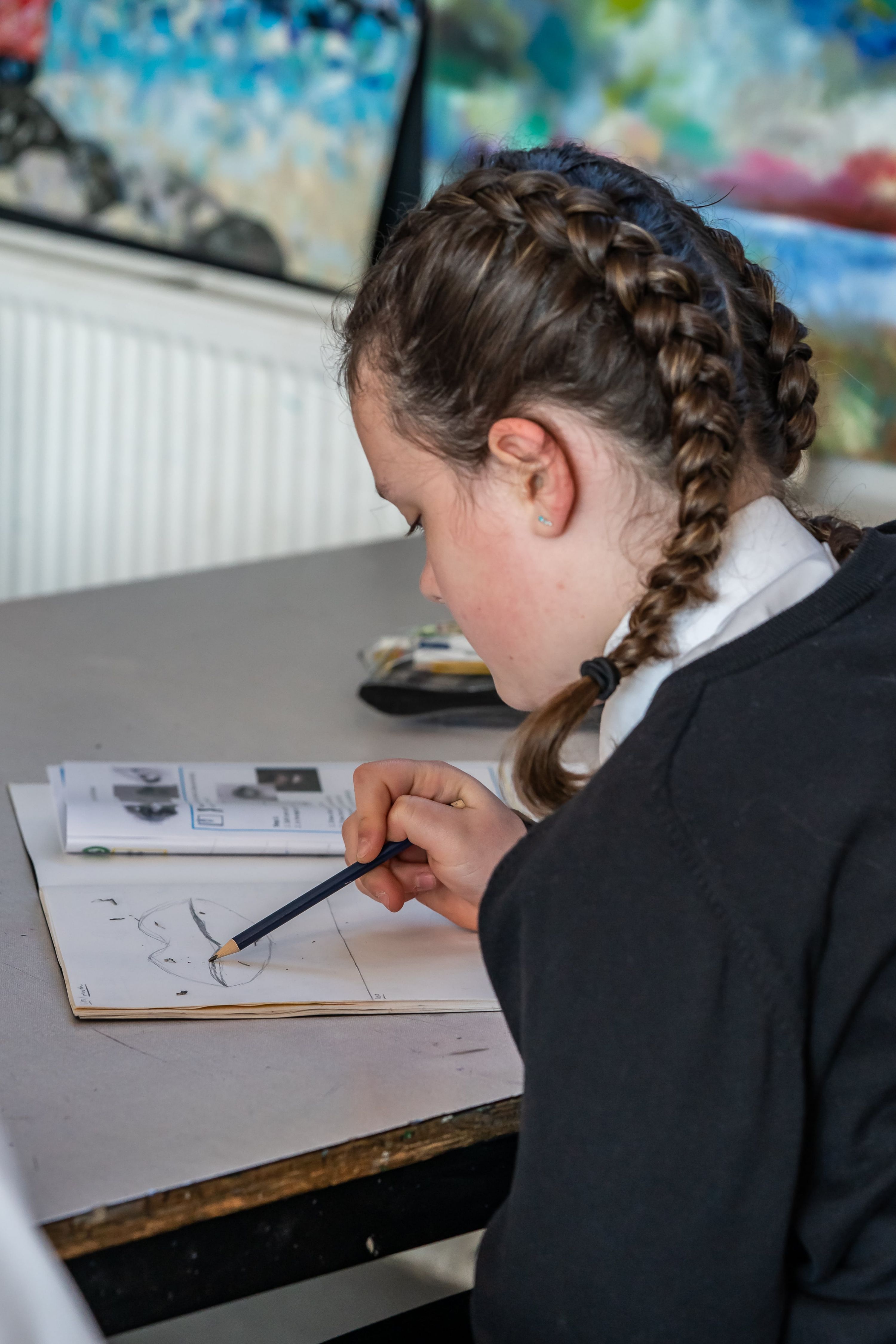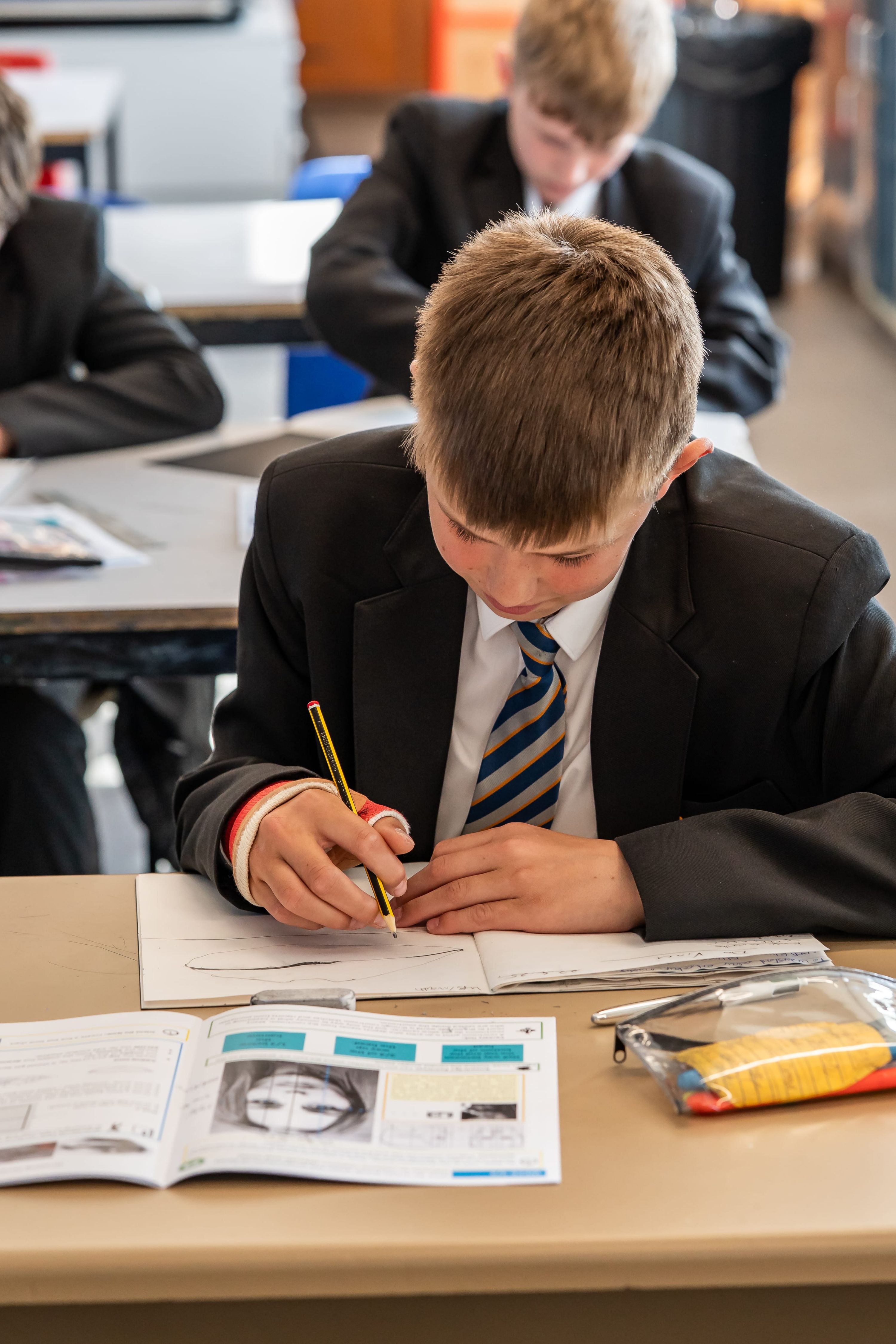Visual Arts
In Key stage 3 students will be taught to develop their creativity and ideas, and increase proficiency in their execution. They will develop a critical understanding of artists, architects and designers, expressing reasoned judgements that can inform their own work.
Students will be taught to:
- use a range of techniques to record their observations in sketchbooks as a basis for exploring their ideas to use a range of techniques and media, including painting
- increase their proficiency in the handling of different materials
- analyse and evaluate their own work, and that of others, in order to strengthen the visual impact or applications of their work
- learn about the history of art, craft, design and architecture, including periods, styles and major movements from ancient times up to the present day.

In Key stage 4 we follow the Edexcel GCSE course. Students can opt for Fine Art, Photography or 3D Art and Design. Each course equips students with the skills to enjoy, produce and engage with the visual arts throughout their lives, and it has immense value as a GCSE subject.

They provide the opportunity for students to:
- explore both contemporary and historical sources of art, craft and design first hand through, for example: visiting museums, galleries, art shows and fairs; experiencing audio-visual productions, including still and moving imagery; their surroundings and environments.
- take an individual approach to their art, craft and design making
- develop the skill of selecting their best and most appropriate work for presentation.
GCSE Art and Design: Fine Art.
The Fine Art course comprises of a coursework project worth 60% of the GCSE and a practical exam project worth 40% of the GCSE. In year 10 students respond to a range of workshops exploring techniques and ideas including painting, drawing, creative constraints, three dimensional approaches, printmaking, and art history before playing to their strengths to create their mock exam project. The coursework project follows this as the students progress to year 11. Students are encouraged to develop and practise their analytical skills as well as their technical skills and to develop their project management and independence as they progress through the course.
GCSE Art and Design: Photography.
The Photography course comprises of a coursework project worth 60% of the GCSE and a practical exam project worth 40% of the GCSE. In year 10 students respond to a range of workshops exploring techniques and ideas including camera controls, drawing, creative constraints, digital editing skills, and photographic history before playing to their strengths to create their mock exam project. The coursework project follows this as the students progress to year 11. Students are encouraged to develop and practise their analytical skills as well as their technical skills and to develop their project management and independence as they progress through the course.
GCSE Art and Design: 3D Art and Design
The 3D course comprises of a coursework project worth 60% of the GCSE and a practical exam project worth 40% of the GCSE. In year 10 students respond to a range of workshops exploring workshop techniques and ideas including 3D printing, drawing, creative constraints, three dimensional approaches, and art history before playing to their strengths to create their mock exam project. The coursework project follows this as the students progress to year 11. Students are encouraged to develop and practise their analytical skills as well as their technical skills and to develop their project management and independence as they progress through the course.
“Art is not what you see, but what you make others see.”
Edgar Degas
What makes us special?
Everyone at HCC has the right to discover and develop their creative voice. We support them to do this through the exploration and connection of the mind and body both in learning to articulate ideas and in the development of cultural understanding and appreciation. We encourage students to explore, discover, and grow their talents, so they can become confident and enthusiastic creators who strive to understand and shape their world.
Assessment
Assessment in Art at KS3 is an ongoing process, combining both summative and formative approaches to track progress and support learning. Each cycle, students review their work throughout the projects allowing teachers and students to identify strengths and areas for development. At the end of each cycle work is summatively assessed, including a knowledge assessment.
At KS4, students are assessed against the specification objectives throughout the course and through mock examinations. These assessments provide valuable insights that inform lesson planning, ensuring targeted support and continuous improvement for every student. The course is 60% coursework and 40% externally set assignment.
Progression & careers
Employers are always looking for potential recruits who are well organised, observant and creative. The GCSE Art and Design courses are a perfect fit for developing all of these key skills. Students can go on to study Art & Design subjects at A level and progress to study design related courses at university and colleges. Many careers benefit from the study of Art & Design including: Media, Architecture, Film, Fashion, Graphic Design, Advertising, Animation, Games Design, Product Design, Theatre/Set Design, Arts Education, Interior Design, Landscape Design, Illustration, Fashion Design, Costume Design, Arts Heritage, Photography, Jewellery Design, Teaching, Conservation ... the list goes on. In fact, any career that you can think of that requires visual literacy in some way benefits from a GCSE in these areas.
Curriculum Map
“Life is art. Art is life. I never separate it.”
Ai Weiwei
